|
|
| |
|
 We do news right, not fast
We do news right, not fast
Note: This blog expresses only the opinions of the blog owner,
and does not represent the opinion of any organization or blog
that is associated with The Golden Rock.
|
|
Archive for the ‘feature’ Category
Saturday, April 9th, 2011
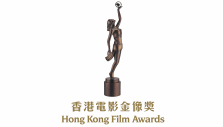
The size tells you how much the awards really matter
We’re at it again - Yes, this blogger will be live-blogging this year’s Hong Kong Film Awards live once again as he watches from the comfort of his own home. I am grateful that Hong Kong ATV has once again picked up broadcasting rights and promised to show the whole thing live without one single cut. That means I will be reporting once again the victories, the #winnings, the celebrity fails, and everything else in between right here on this blog.
If you’re read my awards live blogs, you’ll know that the live blog consists of constant updates minute-by-minute, and the only thing you have to do to stay updated is to click the reload button. As I have turned off comments once and for all here on this blog to prevent spam (hasn’t worked), I will be using my Twitter as an interaction tool in addition to updates on the blog. To keep the interactions all in one search, please use the hashtag #HKFA30 when you tweet about the awards.
And now, the basics:
Date: Sunday, April 17th
Time: 19:45 (7:45pm), Hong Kong/Beijing Standard Time (adjust to your own time zone accordingly)
My job: Update on this blog and interact on Twitter
Your job: Read, click “reload” on the blog to follow the updates, and/or interact on Twitter.
Some time over the next week, I will be posting my own predictions, but you can make your own from the list of nominees.
See you all on the 17th!
Posted in feature, awards, Hong Kong | No Comments »
Sunday, March 13th, 2011
This post is my entry for the Korean Film Blogathon 2011.
As the website that carries this blog is Hong Kong film-related, the way I’m approaching Korean cinema is in comparison with Hong Kong cinema. Some have dubbed the new renaissance of Korean cinema as the new Hong Kong cinema. While that statement is right in a superficial level (new emerging commercial cinema), I wouldn’t call it accurate because of the difference in the two systems. This will be a quasi-academic look at the two systems based purely on my knowledge.
Sorry, what follows will be a whole lot of text and no pictures:
Hong Kong cinema history:
Hong Kong began making films around 100 years ago, but its viability as an internationally-recognized commercial industry didn’t truly come until the 60s with the rival studios/rise of Cantonese cinema, Golden Harvest in the 1970s, and the artistic New Wave in the 1980s. Much of its successes are industry-related, with audience demand mainly driving the type of films being made. As a result, I always dubbed Hong Kong cinema as a type of “hyper-commercial cinema”.
This also applies to the current age of co-productions, where Hong Kong filmmakers are forced to make films with production companies in Mainland China because of its quickly rising box office gross and the government allowing HK-based co-productions to bypass quotas. The old overseas market for Hong Kong films, such as Malaysia and Taiwan, no longer earn much revenue, forcing filmmakers to modify (and sometimes recycle) formulas for a Chinese audience that they assume weren’t previously exposed to their works before.
Korean Cinema History:
The development of Korean cinema is very closely connected to South Korea’s political situation, with history of government censorship (one victim of that I’ve seen is 1981’s THE BALL SHOT BY A MIDGET) and brief period of freedom in the 1970s. With government censorship of films ending in the late 80s, Korean cinema began to explore new social and other issues never explored before. However, audience levels remained low due to Hollywood presence, especially when they began to directly distribute their films.
In late 1990s, Korean producers began to find new ways of investment for films, helping to elevate the production quality of films. With the South Korean government’s protective measure in the form of the screen quota (referring to the time a South Korean cinema must give to exhibiting local films) and increasing attendance at films like THE CONTACT, CHRISTMAS IN AUGUST, and of course, the record-breaking SHIRI, commercial Korean cinema took off to heights never imagined before.
Over a decade after the breakthrough of commercial Korean cinema, it is now one of the biggest film industries in Asia. In addition to commercial success with local audiences, it has also earned critical acclaim with films by directors like Park Chan Wook (JSA, The Vengeance Trilogy), Kim Ki-Duk, Lee Chang-Dong catching international film festival recognition. Its own Pusan Film Festival has also grown to be one of the biggest and most important film festivals in Asia. In other words, in just one decade, South Korea has made itself a self-sustaining film industry, despite recent threats of a bubble burst.
Hong Kong independent film scene - recent developments
This section is going to be a short one, because there’s not all that much to say about Hong Kong independent films. Hong Kong government’s art development council offers funding for making of independent films, and there are a few organizations that facilitate the making and distribution of indie films (particularly Ying E Chi).
However, the problem with Hong Kong indie film (In my opinion) is its reputation. Indie filmmaking is considered an alternative way of expression here in Hong Kong. This might be because Hong Kong cinema panders to commercialism so much that it widened the spectrum between commercial cinema and independent cinema. If indie films are made as a response to commercial films, then they will obviously be even artsy-er than your typical independent film from America or Japan.
I won’t name any examples, but some organizations see “independent” as an expression rather than a mean of expression. In other words, some see “independent” as an excuse to make something tough to understand under the shield of being avant-garde and thought-provoking, not realizing that traditional definition of “independent” is in the context of funding. As a result, independent films in Hong Kong often feel like they are made for the filmmakers themselves rather than the audience.
That creates a vicious cycle where people stay away from indie films in fear of watching something incomprehensible, and not enough cinemas have the guts (and the money) to take on the loss of playing indie films. No distribution, no audience. No audience, no distribution. Meanwhile, Hong Kong indie films are also rarely well-made enough to see play on the festival circuit (though LOVERS ON THE ROAD and CITIZEN KING - both Ying E Chi films - got festival play around the world), leaving less and less options for HK indie films to get the exposure they need.
Meanwhile, YEC also tried to get its own Independent Film Festival off the ground after the infamous feud with the Hong Kong Asian Film Festival several years ago. However, its partial focus on beating out the HKAFF (mainly by programming it so closely to it and holding its annual press conference on HKAFF’s opening day) hasn’t exactly helped publicity or attendance.
South Korean indie scene vs Hong Kong indie scene
Every year, quite a few Korean independent films cross my path either via film festival or my own film reviewing work. They cover a variety of genres (though they mainly share a similar minimalist visual style) and various types of characters. However, many of them have one thing in common: They include government funding. In addition to the screen quota (which has been reduced to much protest), South Korea has the Korean Film Council to give funding to local films, including art films. Like Hong Kong, South Korea also has several film schools for film training.
Meanwhile, the Hong Kong government finally started its own film fund a few years ago. However, indie filmmakers have had little access to the fund due to constraints: 1) The film’s producer and/or director must have made two films, 2) The fund will only provide up to 40% of the funding, provided the film doesn’t cost more than HK$15 million, 3) the film must be “commercially viable” and 4) have secured third-party financing already. Of course, it did help films like the third McDull animated film, THE BREAK-UP CLUB, and Xiong Xin Xin’s COWEB (which still hasn’t seen any HK release) get made, but this still leaves many independent filmmakers out, especially when the words “commercial viable” is so subjective.
Meanwhile, Hong Kong does have film schools. I know because I attended one of them. These film school students also have the annual Fresh Wave Competition, with all qualified productions each getting HK$40,000 to make a 30-minute short film. However, the Arts Development Council-sponsored contest recently made themselves independent of the Hong Kong International Film Festival, leaving them on their own to attract audiences. Also, my own film school is mostly made up of Mainland Chinese students who shoot their thesis films in China and seem to be aiming for careers there.
In the end, there are plenty of opportunities for aspiring filmmakers in Hong Kong to make it, but it all ultimately goes back to quality. Hong Kong commercial filmmakers need to learn that “independent” isn’t a dirty word, and that it’s OK to make an audience-friendly film WITH personal expression. The Korean indie scene has its share of art films that are not audience-friendly, but they also have films that have attracted audiences not just at home, but overseas as well, making it a film scene with enough variety to attract all kinds of audiences.
Of course, you can also say it comes down to audience numbers. It’s amazing for a city with just six-seven million people to have its own film industry, let alone an independent one, so perhaps we should be thankful for what we can get. However, I’d argue that keeping this miracle industry alive is an even bigger motivation for independent filmmakers to make works that would travel beyond their own friends. I’m not calling for independent filmmakers of Hong Kong to give up their voices, and I’m not calling for them to blame the government for a lack of support. I am calling for a better investment models, and more awareness by HK indie filmmakers of what their audiences want to see without losing themselves.
Or they can all just move to Korea.
Disclaimer: I can’t guarantee all the details in this blog entry are correct, but I can say that my general points are still valid.
Posted in editorial, feature, South Korea | No Comments »
Wednesday, March 9th, 2011
Before this blogger gets into the Korean film blogathon and talking more about China, I want to get into detailing one of the greatest experiences in LoveHKFilm’s history. Yes, we went to see an Ekin Cheng concert.
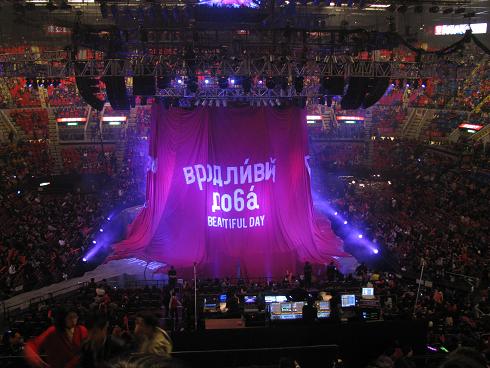
No, I don’t get the Russian influence, either.
Boss Kozo hass already seen the last Ekin concert, but this marks the first time half the LoveHKFilm writers (yes, all two of us) went out and saw the unofficial ambassador of LoveHKFilm.com, making this THE LoveHKFilm.com event of the year so far.
Besides, we couldn’t get tickets to the Faye Wong concert.
Of course, beyond the LHKF context, I have my own reasons for going. Growing up in the United States during Ekin’s popularity peak, I was exposed to my Chinese-American classmates worship the YOUNG AND DANGEROUS series and its star, Dior/Ekin/Noodle Cheng. I literally spent my teenage-hood listening to his music, both voluntarily and involuntarily. It didn’t (and still doesn’t) matter whether Ekin has any real musical talent - they will always be a big part of my life’s soundtrack.

Yay!
Because of his history as an actor, at least half the setlist comprised of movie songs like those from YOUNG AND DANGEROUS, LEGEND OF SPEED, STORM RIDERS, FEEL 100%, and of course, A MAN CALLED HERO. The other half consisted of songs from pop singer Ekin, which surprised me quite a bit because I didn’t know 1) He had that many songs to share, and 2) I would know so much of them.
Of course, a certain webmaster wasn’t so familiar, and had to kill time some other way:

And he STILL had to use the Mighty Eagle.
So, to see Ekin live and perform those songs again was most definitely a rewarding experience. Yes, he missed lyrics, he missed notes, and the tree on the stage was weird, but that doesn’t mean I didn’t have fun.
And now, some more cool pictures:
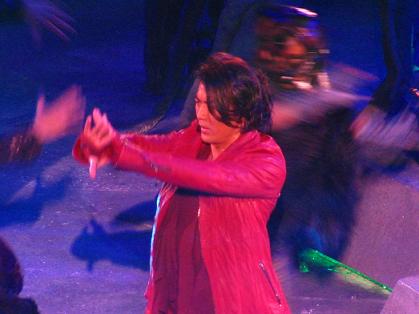
“Let me gather my chi and aim at that Kozo guy…”

Musical guest Pakho Chow (SPLIT SECOND MURDERS) and Noodle.

Ekin Cheng for President!
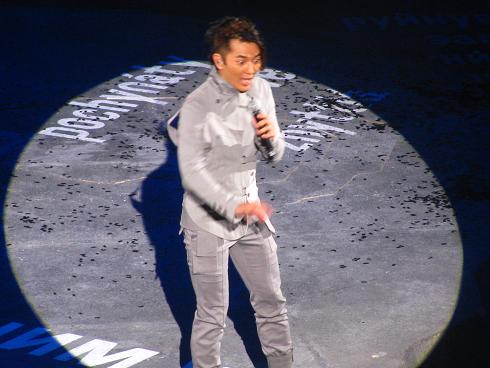
“Holy crap, Kozo still write movie reviews?!”
And ladies and gentlemen, I save the best for last. I give you THE best Ekin Cheng expression EVER:

Just make your own caption.
Posted in feature, humor, music, Hong Kong | No Comments »
Saturday, February 26th, 2011
Dedicated followers of my going-on’s might know that I went off for a week in Western China during the Lunar New Year period. For someone that has only been to Shenzhen for no longer than a few hours, this first trip inside China is both daunting and exciting. Of course, since it was a personal trip, not everything is worth talking about here, but I’ll post some movie-related things on this blog entry, and there were a few of those:
Since there’s only one direct chartered flight from Hong Kong to the Xinjiang capital of Urumqi, I had to fly out from Guangzhou, THE major city in Southern China. The only affordable food in Baiyun Airport was McDonald’s and a fast food chain whose title translates to “Real Kung Fu”. Why is the place called a “Hong Kong-style” fast food place? This is why:
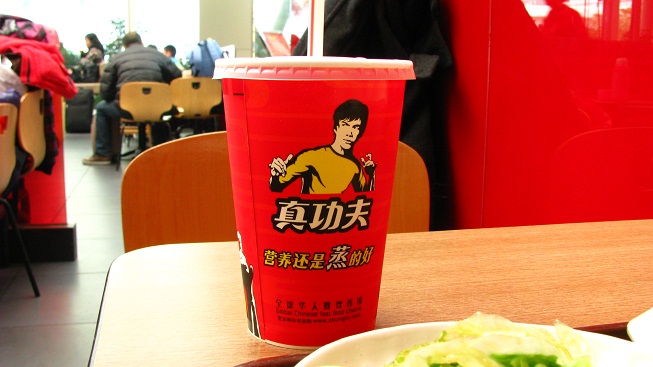
This chain can afford to buy his image, and Manfred Wong can’t afford to buy his life story?
Since it was the winter, there wasn’t much to do in Urumqi, except for doing the Lunar New Year family visits, and of course, watching movies. There aren’t many newer movie theaters in Urumqi, though the theaters have already all switched to digital projections a few years back. One of the most popular movie theaters in the city is The People’s Cinema. Located in the southern central part of town:
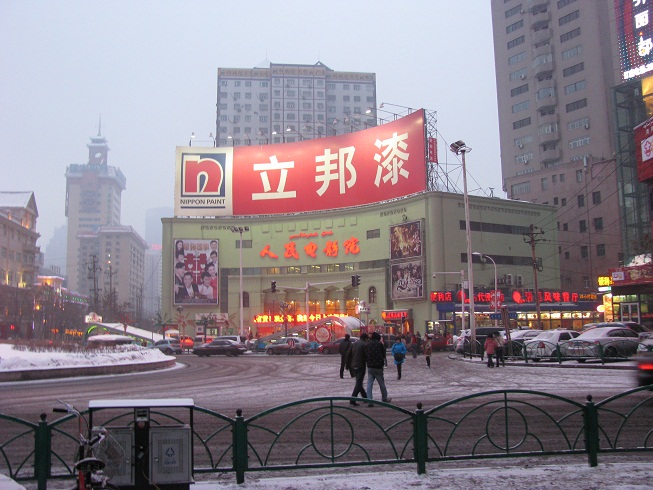
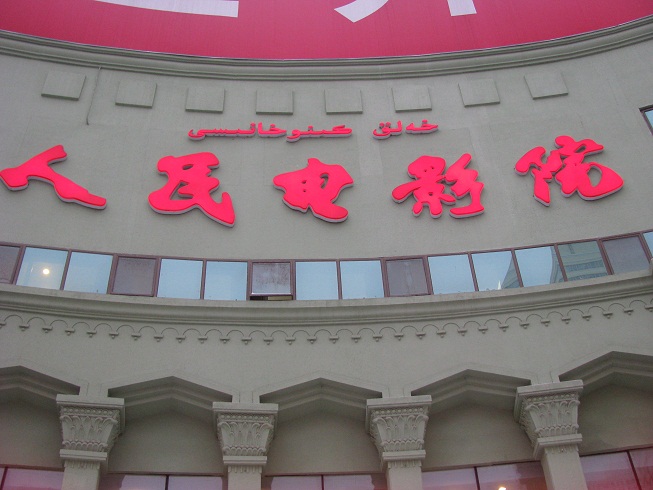
You might be wondering why there’s Arabic-like letterings above the Chinese letters. That’s because 45% of the population in Xinjiang Province are Uyghurs, and they speak their own unique language. Instead of Chinese and English, most official signs are in Chinese and Uyghur instead. The Han Chinese-Uyghur ratio leans much, much more towards Han Chinese in the capital city of Urumqi, but language policy is language policy.
Anyway, The People’s Cinema, which is literally across the street from the Peace Theater, is quite large - about five stories, and has a total of 12 screens:
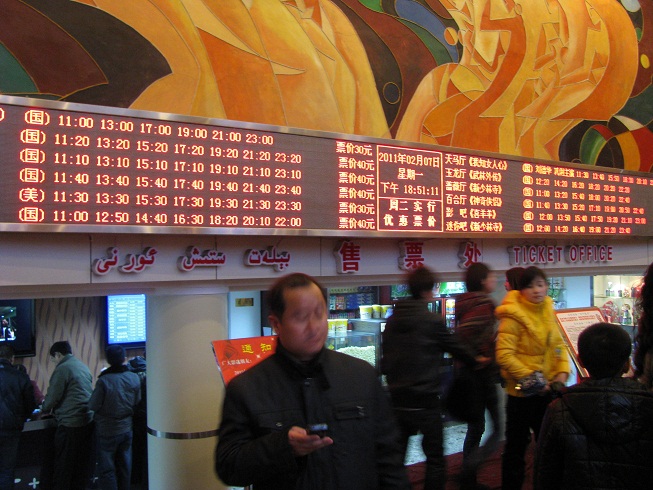
The box office. Average ticket price: RMB40
I wanted to catch Andy Lau’s WHAT WOMEN WANT, but for time reasons, I caught the Mainland Chinese comedy MY OWN SWORDSMAN instead:

Oh, look, there’s that other Andy Lau movie, too.
Even though MY OWN SWORDSMAN proved to be immensely popular, we got sent up to the small house on the top floor, which I estimated had less than 100 seats. The screen wasn’t big (perhaps no smaller than a small cineplex house in Hong Kong), and the film was shown in digital projection. However, my big problem was the audio. Despite having been renovated (or so I was told), the theater’s surround speakers were the only thing that sounded clear and normal. The center speaker (located behind the screen) was muffled and flat. Since the dialogue almost always come from the center speaker, that means it was very hard to catch the dialogue. Thankfully, since the film relied on local accents for its humor, it has simplified Chinese subtitles.
I will be reviewing the film for the site later, but I will say that I enjoyed it far more than I had expected. The Chinese language-based humor was great, and even a lot of the film’s modern humor (infomercial parody, internet slangs) translated to plenty of laughs. The audience was talky as hell, as one can expect for a commercial film screening in China, but it didn’t totally detract from the film experience.
I went to a multiplex on the other side of town a few days later for WHAT WOMEN WANT, which you can read the review for here. Unfortunately, I did not take pictures of the theater, but it’s a small, six-screen multiplex on the third floor of a hotel building that I couldn’t find any internet listing for. Worse yet, it’s also across the street from the city’s brand-new multiplex. I still can’t figure out why we didn’t go there instead, because the Tianshan multiplex not only played the film below the usual volume (which may be why the film felt like it dragged a little bit), it also played the film in the wrong aspect ratio in order to fit it on its permanently 1.85:1 aspect ratio screen.
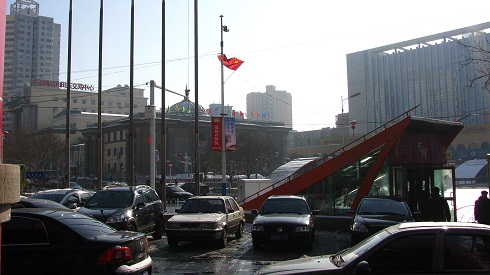
The above is from across the street of the city’s other big theater (the one with the domed roof), the People’s Theater (I know, it’s always people’s something in a communist country). Not only does it now have 3D equipment, it also houses more than 10 auditoriums. It’s Urumqi’s oldest theater, and it’s been renovated as well. When I entered, it had metal detectors at the entrances due to the city’s security situation.
The general assessment I get is that Urumqi still hasn’t quite caught up to being good enough to really attract people to get out of their houses and to the movies. I’ve heard before that Chinese multiplexes have to be up to a good standard in order to make people feel like movie tickets are worth buying, and either the people of Urumqi don’t care enough, or people just don’t know how to run a decent theater. Cushy seats and digital projections make things easier, but you need people who know how to project a film properly or make sure the speakers run normally to give people the true theater experience. Sadly, that’s not what I saw.
As for the rest of the trip, I ate a lot of lamb, and I literally could not find a place that had a decent selection of legit DVDs. Such is the biggest city in Western China.
One day, I hope to go across the river over to Shenzhen to see what the newer movie theaters are like, and more on the movie world from a moviegoer’s point of view in China.
Posted in feature, China | No Comments »
Sunday, January 9th, 2011
It’s the time of year when everyone’s making top ten lists, and it’s no exception for myself. I’ve compiled a top twelve list for my Facebook that covers pretty much everything I’ve seen. Now, it’s time to get into why I chose 11 of those films, plus 10 (out of the 40 I chose) special mention films. I intentionally didn’t include Hong Kong films to save them for the 2010 LoveHKFilms Awards. I will post my ten picks then.
They don’t really mean anything, other than the fact that these are the films I liked from 2010 (Yes, I do like movies once in a while). You may like them, and you may not; that’s how opinions work:
Special Mentions (in no order):
Secret Reunion (Korea), Fantastic Mr. Fox (USA), Up in the Air (USA), Dabaang (India), A Serious Man (USA), Ghost Writer (France/Germany/UK), Udaan (India), Sawako Decides (Japan), Last Train Home (China/UK/Canada), Golden Slumbers (Japan).
11. Villain (Japan, Director: Lee Sang-Il)
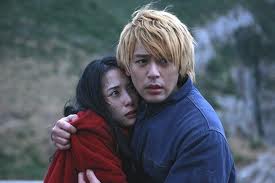
A prestige movie that actually earns respect rather than assumes it, this emotionally intense drama about a murderer on the run with his lover works better as a film about the chain reaction of a crime than a road movie. With six of its leads getting recognized at the Japan Academy Prize, it also has one of the best casts of the year.
10. 3 Idiots (India, Rajkumar Hirani)
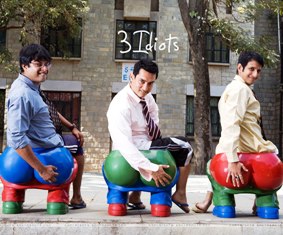
Watching it with a full house in Hong Kong’s Cultural Center taught me what a true crowdpleasing film is. Packing plenty of laughter, romance, and melodrama in its 170-minute running time, 3 IDIOTS is an emotional roller coaster that had the audience reacting with its every move. Aamir Khan, at 44 years old, managed to pull off playing a 20-year-old engineering student with star charisma. This, ladies and gentleman, is what a star vehicle is all about.
9. Dear Doctor (Japan, Director: Miwa Nishikawa)
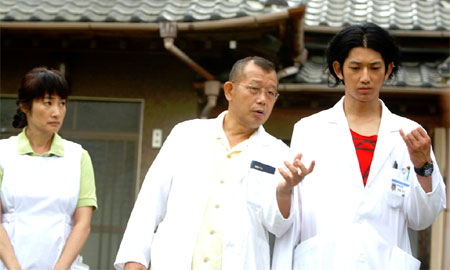
A drama about a small town who has been conned by a hustler pretending to be the town doctor, Miwa Nishikawa’s DEAR DOCTOR is quietly powerful in making its impact. Tsurube Shofukutei plays a twisted version of his comedian persona with his brilliant portrayal of the con man. You may not remember how the entire movie goes, but it’s full of little moments that will stick with you long after your viewing.
8. Toy Story 3 (USA, Director: Lee Unkrich)
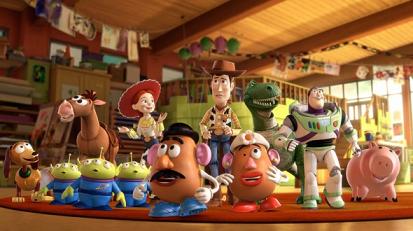
Having literally grew up with the franchise, I was deeply touched to see this trilogy come to an end the way it did. This comes after a potentially traumatic scene showing all the characters looking at death in the eyes. I don’t remember much of the first two-thirds (I do remember they were enjoyable), but I may never forget those two scenes in the final 15 minutes of the film.
7. Let the Bullets Fly (China, Director: Jiang Wen)

I’ve gushed plenty about this film, so here’s a shorter version of it: Wickedly funny, brilliantly written, and hugely entertaining, LET THE BULLETS FLY may be the most entertaining Chinese blockbuster I’ve seen in recent years. Jiang Wen found his balance between art and commerce with this Chinese Western film where witty bantering fly far faster than bullets. Chow Yun Fat not speaking a word of Cantonese doesn’t even matter to me this time.
6. Poetry (South Korea, Director: Lee Chang-Dong)
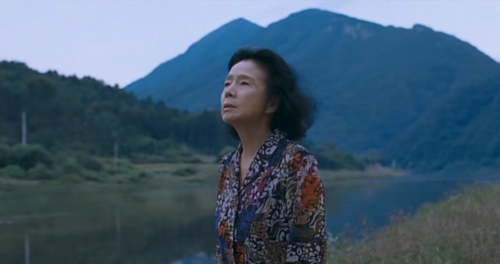
Lee Chang-Dong is great at two things: Telling emotionally powerful stories without going into melodramatic hysterics, and getting incredible performances out of actresses. He does both almost effortlessly with POETRY, a long journey about finding redemption through the art of words.
5. The Social Network (USA, Director: David Fincher)
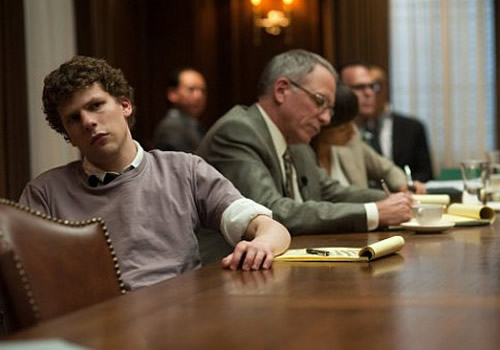
Very few people writes witty banters like Aaron Sorkin does. No one in real life ever talks like his characters, but everyone should want to speak as eloquently as they do. With director David Fincher, the two has created a film that taps into the mindset of the internet generation so well that movie critics have to get on the bandwagon to feel they’re hip. Beyond the talk about programming and facebook, THE SOCIAL NETWORK is also a damn good film about a friendship gone sour over fame and fortune. Who cares if it’s all real or not?
4. Inception (USA, Director: Christopher Nolan)

A smart gimmick, big-budget spectacle, and an involving heist story make this another high in director Christopher Nolan’s action blockbuster. The spectacle looks great, the film consistently entertains, and the cast is uniformly good. All the money in the world (or Hollywood) can’t replace a good idea and a great script, and that’s why INCEPTION is the best big-budget blockbuster of the year.
3. Apart Together (China, Director Wang Quan’an)
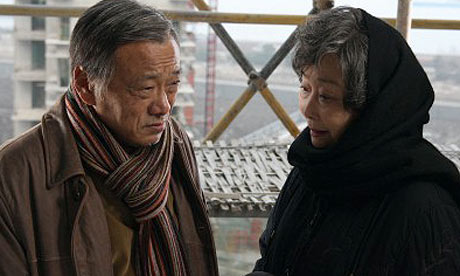
No political undertones in director Wang Quan’an’s drama about a former Nationalist soldier returning to Shanghai to see his former lover and decides to take her back to Taiwan with him. The drama could’ve been a crushing bore with dreary views of Shanghai and contemplative storytelling, but APART TOGETHER is actually a surprisingly comedic romantic triangle that’s far better than those Patrick Kong “everybody cheats on everybody” youth romances.
2. The Secret in Their Eyes (Argentina, Director: Juan Jose Campanella)
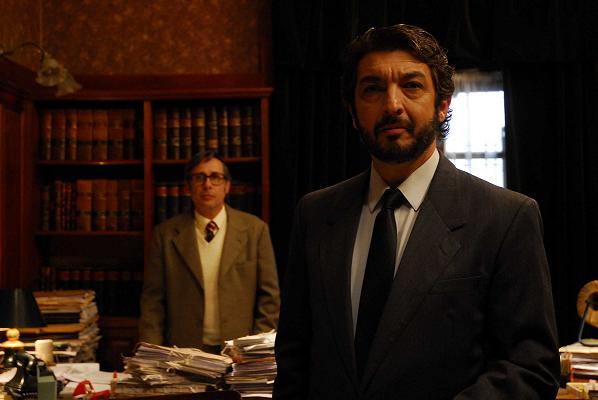
This involving police procedural drama doesn’t bring anything new to the genre (except for the amazing 5-minute chase sequence in the middle), but it does what it does so well that it doesn’t matter. The unrequited romance is touching, the crime story (more like a howcatchhim than a whodunit) brings plenty of tension, and the buddy police procedural reaches surprisingly powerful heights. This is how you take a crime film to award-winning heights.
1. Confessions (Japan, Nakashima Tetsuya)
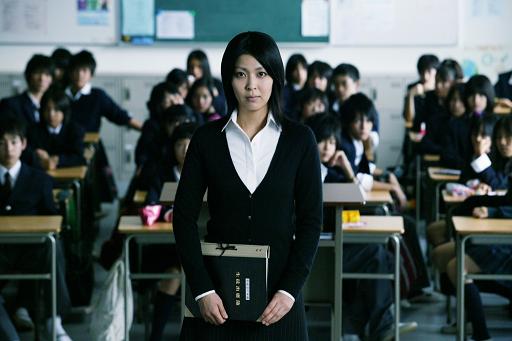
While AKUNIN is an out-and-out an award bait film, no one expected a film by a director who turns tragedy into bubble-gum pop made of explosions of color to become the film representing Japan at this year’s Academy Awards. Nakashima Tetsuya’s 109-minute-long music video makes up for the absence of color with an incredibly measured performance by Matsu Takako, a stunning soundtrack of existing material, and a wicked revenge story. I saw this film for the first time on an airplane, and its power still managed to infect me. This is the role model all MTV-style filmmaker should aspire to. I’m looking at you, Hong Kong filmmakers.
Posted in feature | No Comments »
Friday, January 22nd, 2010
Finally, we wrap up my favorite 25 Panasian Films of the Decade..
Here are what happened in the last two parts, in case you’re just tuning in:
Part 1
Part 2
Today, it’ll be the pivotal Top 10, and the special awards.
But, for the last time, the disclaimer: I watch a lot of films, but like anyone who doesn’t get to travel to film festivals worldwide or have that much time to watch every Asian film existed, I missed out on a lot of stuff. I also have my own biases. I don’t care for Achitpatong, Kim Ki-Duk, or Hong Sang-Soo, which means those art films one might’ve seen on those best of the decade list by western organizations will be missing here. Mainly, they’re not because I really don’t like them - I just couldn’t find the time to watch them.
Hence, this list is totally interactive. This means you’re welcome to offer your own list or even talk about my picks. But I can say it’s unlikely to find a definitive top 10 list out there, since 1) Everyone has different tastes, and 2) there were so many films that I had to expand my list to 25.
So now, on to the top 10:
10. 5 Centimeters Per Second (2007) - Japan - Directed by Makoto Shinkai
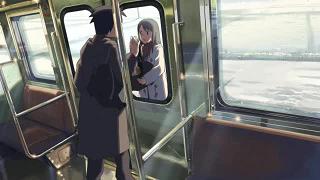
If anyone is looking for Wong Kar-Wai on animation, this is it. Split into three parts for a barely feature-length anthology of thinly connected segments, this is a story about isolation and loneliness that would’ve worked just as well in live-action, but the wintery landscape of Tokyo and summer seaside Kagoshima look even more beautiful through Shinkai’s eyes.
9. Secret Sunshine (2007) - Korea - Directed by Lee Chang-Dong

A lot of my love for this film is due to the lead performance. However, writer-director Lee Chang-Dong also deserves a lot of credit for the unflinching portrayal of such raw emotions and providing a thought-provoking look at the meaning of religion in people’s lives. Of course, Jeon Do-Yeon does do all the work in her award-winning performance as the film’s central character.
8. Love Exposure (2008) - Japan - Directed by Sion Sono - LoveHKFilm review
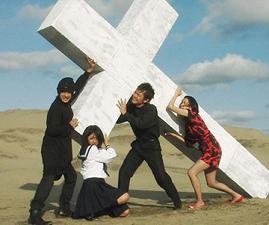
Anyone who makes a 4-hour film and pulls it off as well as Sion Sono did here deserves a place on this list. Filled with upskirt photos, religious satire, evil cults, and crossdressing, Love Exposure is definitely a cinematic achievement, despite its technical and storytelling flaws. It’s also a grand example of a film that needed to be put on a leash, but when it’s this fun to watch, it’s perfectly fine to let it loose a little longer.
7. Oldboy (2003) - Korea - Directed by Park Chan-Wook - LoveHKFilm review
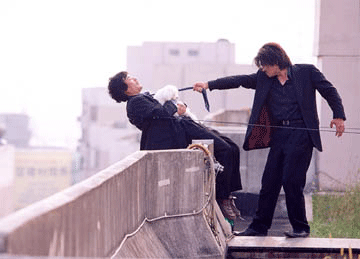
Park Chan-Wook hit his filmmaking peak with the middle film of his Revenge trilogy, a poetically violent film that explores the motives and meaning of revenge. Propelled by Park’s unique visual style and an intense performance by Choi Min-Sik, Oldboy elevated the visual asethetics of the New Korean Cinema to a whole new level.
6. Blood and Bones (2004) - Japan - Directed by Yoichi Sai
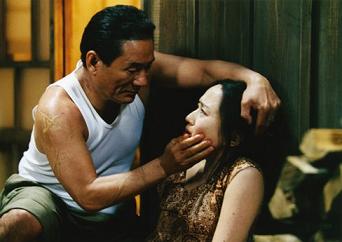
The placement of Blood and Bones this high on the list is, like Secret Sunshine, mostly attributed to its monster of a main character played convincingly by Takeshi Kitano. Filmed without one bit of sentimentality by Yoichi Sai, this is family melodrama with a real nasty edge. As brutal as it is, Kitano’s performance is like a magnet on the audience, repelling them while forcing them to watch at the same time.
5. All Around Us (2008) - Japan - Directed by Ryusuke Hashiguchi 0 LoveHKFilm review

Ryusuke Hashiguchi’s portrait of a decade in the life of a married couple is unassumingly brilliant in its subtlety. Filled with quietly powerful moments, smart visual storytelling, and an award-winning performance by Tae Kimura, this is a film that has stuck with me ever since I first watched it without subtitles in a Japanese theater.
4. Memories of Murder (2003) - Korea - Directed by Bong Joon-Ho - LoveHKFilm review

Out of the Korean New Wave filmmakers, Bong Joon-Ho has proven himself to be one of the most versatitle and talented around. His police procedural/social commentary drama, based on a real series of murders in a Korean small town in the 80s, remains just as powerful and compelling now as it did when it first came out earlier in the decade.
3. Nobody Knows (2004) - Japan - Directed by Hirokazu Kore-eda
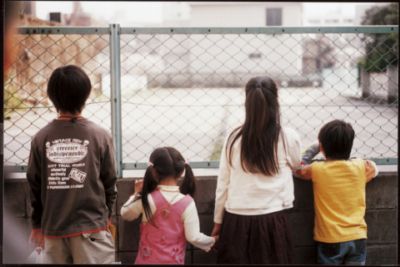
My friends living in Tokyo tell me that the city is like the New York of Japan, filled with uncaring unbanites that would ignore any tourist that seems to be in trouble, and Kore-eda’ unflinching portrait of that society is heartbreaking and powerful, but never exploitative. Working with his child actors during the three-year shoot, Kore-eda has crafted a masterpiece that is more than the minimalist arthouse style many of his contemporaries have tried to imitate.
2. Spirited Away (2001) - Japan - Directed by Hayao Miyazaki
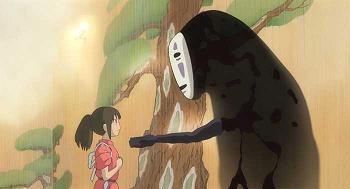
I’m not a fan of anime, which makes picking this Hayao Miyazaki film so high up a rather strange choice for those who know my taste. Actually, that makes this all the more impressive, especially in Miyazaki’s ability to transport his character (and the audience) into a wonderfully-realized world of dragon spirits, masked phantoms, and hopping lamps. Truly a wonderful adventure for this generation and the generations to come
1. Yi Yi - A One and a Two (2000) - Taiwan - Directed by Edward Yang
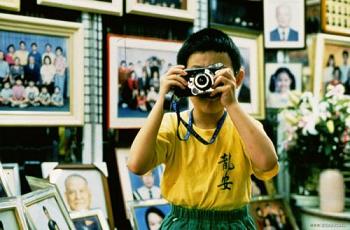
This three-hour minimalist urban epic by Edward Yang is poignant, touching, sublime, sometimes funny, and flat-out brlliant. This is as close as possible to a perfect film, and I cannot think of a better candidate for the top Panasian film of the decade.
Aside from the films that have been mentioned, there are also special prizes for films outside the list or filmmakers that deserve special shout-outs:
Game-Changer of the Decade: Cape No. 7
It’s not a great film, but any film credited for resuscitating an entire film industry and beat the record for the highest-grossing local film by a mile is a pretty damn important one.
Best blockbuster: Bayside Shakedown 2
A sequel that is even more ambitious than its predecessor in terms of both budget and storytelling, the second screen version of the successful TV show is smart fun masterfully directed by Katsuyuki Motohiro. It doesn’t work on its own because of all the recurring characters and running jokes, but it’s much, much better than it deserves to be. Bring on Bayside Shakedown 3.
Style-Over-Substance Award: Kim Jee-Woon
Kim is a director that has transcended every genre he has dipped in. While his stories don’t have the impact of contemporaries like Park Chan-Wook or Bong Joon-Ho, Kim’s directorial skill is certainly at the same level.
Most Likely Heir to Studio Ghibli: Mamoru Hosada and Madhouse
The Girl That Leapt Through Time and Summer Wars were fun crowdpleasers that also had great storytelling and memorable characters. They may not have the same storytelling sensiability as Miyazaki and Ghibli, but they may very well be the next big thing, and deservedly so.
Best Director: Bong Joon-Ho
Bong made his first feature film - Barking Dogs Never Bite - in 2000, and with just three films after that, he has solidified his place as one of the best Panasian directors working today. With every work, he elevates himself to a new level, and it’s hard to imagine him getting any better in the next decade. Then again, he’s Bong Joon-Ho, so who knows?
Just to recap, Here’s the complete list:
1) Yi Yi
2) Spirited Away
3) Nobody Knows
4) Memories of Murder
5) All Around Us
6) Blood and Bones
7) Oldboy
8 ) Love Exposure
9) Secret Sunshine
10) 5 Centimeters Per Second
11) Blue Gate Crossing
12) Oasis
13) Joint Security Area
14) Tony Takitani
15) Still Walking
16) Mother
17) One Fine Spring Day
18) Yasukuni
19) Battle Royale
20) The Host
21) Fish Story
22) City of Life and Death
23) Departures
24) Island Etude
25) Love of Siam
And that’s it. That was fun, but exhausting, which is why I’m glad we won’t have to do this for another 10 years. Remember to let me know where you agree and disagreed in the comments section, and if you haven’t seen any of these films (including the special mentions), then go watch them.
And we here at LoveHKFilm would prefer you to gain access to these films from Yesasia.com , because every time someone buys legit, an angel gets his wings.
Posted in feature | 12 Comments »
Wednesday, January 20th, 2010
Today, I continue my favorite 25 Panasian films of the decade.
But again, the disclaimer: I watch a lot of films, but like anyone who doesn’t get to travel to film festivals worldwide or have that much time to watch every Asian film existed, I missed out on a lot of stuff. I also have my own biases. I don’t care for Achitpatong, Kim Ki-Duk, or Hong Sang-Soo, which means those art films one might’ve seen on those best of the decade list by western organizations will be missing here. Mainly, they’re not because I really don’t like them - I just couldn’t find the time to watch them.
Hence, this list is totally interactive. This means you’re welcome to offer your own list or even talk about my picks. But I can say it’s unlikely to find a definitive top 10 list out there, since 1) Everyone has different tastes, and 2) there were so many films that I had to expand my list to 25.
So, now, on with Numbers 19-11:
19. Battle Royale (2000) - Japan - Directed by Kinji Fukusaku - LoveHKFilm Review

This extreme re-imagined version of Lord of the Flies is not only on the list for the controversy it raised at the time, but also for its inflammatory look at a new generation of Japanese youth by one of Japan’s oldest rebel directors. It’s violent, it’s disturbing, and it dares its audience into enjoying its violence. However, let’s forget its sequel ever existed.
18. Yasukuni (2007) - Japan/China - Directed by Li Ying
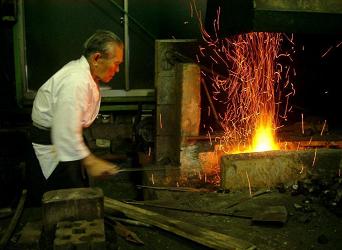
Chinese director Li Ying and Japanese theaters received death threats for making and showing this direct cinema look at the controversial shrine on its most controversial day of the year. For a Chinese-made film about such a Japanese subject (Even most of Li’s crew is Chinese), this is about as “balanced” a look on the subject as it can possibly get. Li simply stands back and captures the chaos over the role of the shrine, and the result is quite eye-opening. Anyone who calls this propaganda for any side has no idea what they’re talking about.
To this day, there is not English-subtitled video release out there.
17. One Fine Spring Day (2001) - Korea - Directed by Hur Jin-Ho
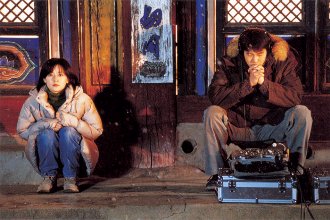
Hur Jin-Ho’s chronicle of a doomed relationship remains one of the most accurate depictions of romance I’ve seen on screen. His minimalist style and the lack of a female perspective here may make it inaccessible to some, but for those that can relate, it serves as a painful reflection of the ones that got away.
16. Mother (2009) - Korea - Directed by Bong Joon-Ho - LoveHKFilm review
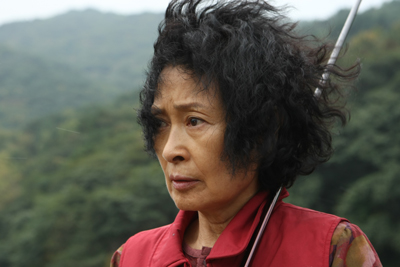
Bong Joon-Ho’s mystery-thriller is an example of fine technical filmmaking, with every cut measured precisely and every camera movement calculated to get its intended effect just right. Its morally ambiguous ending may disturb some, but it’s the twist on “family values” and Kim Hye-Ja’s performance that make it so brilliant.
15. Still Walking (2008) - Japan - Directed by Hirokazu Kore-eda - LoveHKFilm review
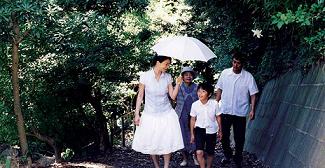
Kore-eda takes on Yasujiro Ozu in this dramedy about the modern family and the things slowly breaking it apart. It appears light on the surface, but Kore-eda’s script (based on his own novel) keeps its conflicts and secrets just underneath the surface, waiting to come out (In other words, just like any other family). Even then, it’s also surprisingly funny at points.
14. Tony Takitani (2004) - Japan - Directed by Jun Ichikawa - LoveHKFilm review
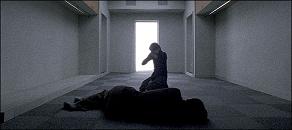
The only Haruki Murakami screen adaptation to date (until the end of the year, when Norweign Wood is released) is also very successful is taking the author’s melancholic writing style for the big screen. Director Jun Ichikawa designed the brilliant “page-turning” transitions between scenes to keep up with its literary source, and the music by Ryuichi Sakamoto is hauntingly moving. It’s short at 64 minutes, but for a Murakami fan, every one of those 64 minutes has been well worth the wait.
13. Joint Security Area (2000) - Korea - Directed by Park Chan-Wook - LoveHKFilm review
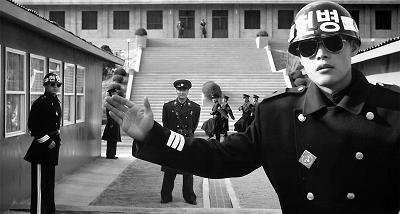
Many Korean blockbusters deal with the separation of the two Koreas, and this one rank as the best exploration of that relationship. While Kang Je-Gyu turned the sensitive topic into slam-bang blockbuster material (twice!), Park Chan-Wook used this Rashomon-style procedural mystery to explore whether reconciliation is truly possible, and the result is Park proving himself as the storyteller before he became Park the visual showman.
12. Oasis (2002) - Korea - Directed by Lee Chang-Dong
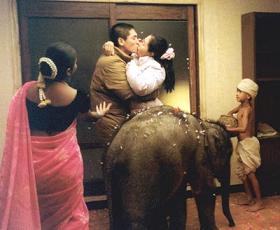
Lee Chang-Dong’s drama about an ex-convict and a woman with cerebral palsy defined the careers of its director (who later became a minister of culture for several years) and lead actress Moon So-Ri. Its choice to depict such a graphic, but gentle romance between two disabled (in their own way) people shows the guts of the emerging Korean cinema and the artistic heights it could reach.
11. Blue Gate Crossing (2002) - Taiwan - Directed by Yee Chin-Yen - LoveHKFilm review
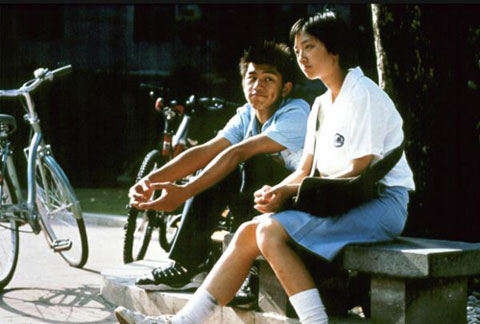
Eternal Summer and Miao Miao owe a great deal to this simple, but beautifully-made youth film. The peace of Taiwanese suburban life captured by writer-director Yee Chih-Yen is memorably serene, and two-thirds of its young cast has deservedly moved on to far bigger things as well. It’s not a particular hard-hitting film compared to other films on the list, but its influence on future works of the genre makes it a more important film that it suggests.
And next time: The finale - The Top 10 Panasian films of the decade, and the special awards. Let the general indifference begin!
Posted in feature | 1 Comment »
Monday, January 18th, 2010
Since everyone (including lovehkfilm’s own readers) are doing their best of the decade blog, I figure I shouldn’t miss out on the fun. Panasian is a fairly abstract word, but for the purposes of this list, they’ll simply films made in Asia from 2000-2009 and cannot qualify for the lovehkfilm awards (hence Lust, Caution and Hero’s exclusions).
And now, the disclaimer: I watch a lot of films, but like anyone who doesn’t get to travel to film festivals worldwide or have that much time to watch every Asian film existed, I missed out on a lot of stuff. I also have my own biases. I don’t care for Achitpatong, Kim Ki-Duk, or Hong Sang-Soo, which means those art films one might’ve seen on those best of the decade list by western organizations will be missing here. Mainly, they’re not because I really don’t like them - I just couldn’t find the time.
Hence, this list is totally interactive. This means you’re welcome to offer your own list or even talk about my picks. But I can say it’s unlikely to find a definitive top 10 list out there, since 1) Everyone has different tastes, and 2) there were so many films that I had to expand my list to 25.
My criteria: The films have to be good, and if they served some kind of bigger purpose, it’s more likely I would put them here than some award bait film, like Hula Girls. I liked the film, and it swept a lot of the awards in Japan that year, but I hesitantly kept it off the list because it wasn’t as notable as some of the other films I’ve picked here.
So, for part 1 - numbers 20-25, and the 20 special mentions to tell you what got left out:
Special Mentions:
The Assembly (China)
Life is Cool (Korea)
Summer Wars (Japan)
The Girl that Leapt Through Time (Japan)
Suite Dreams (Japan)
Air Doll (Japan)
Fine, Totally Fine (Japan)
The Chaser (Korea)
I Just Didn’t Do it (Japan)
Seagull Diner (Japan)
The Good, the Bad, the Weird (Korea)
A Bittersweet Life (Korea)
President’s Last Bang (Korea)
Tokyo Sonata (Japan)
Memories of Matsuko (Japan)
A Stranger of Mine (Japan)
Linda Linda Linda (Japan)
Il Mare (Korea)
My Dear Enemy (Korea)
God Man Dog (Taiwan)
And now, 20-25:
25. Love of Siam (2007) - Thailand - Directed by Chookiat Sakveerakul - LoveHKFilm review

Note: This refers to the director’s cut, which runs just under three hours.
The center of this Thai film is a gay romance between two teenagers, but it’s about a lot more than that, and it works on those other levels too. Despite some awkward directing, the film runs surprisingly fluid, and the acting is uniformly strong. A Thai gay romance is rare enough already, but one that is this good is even more rare.
24. Island Etude (2007) - Taiwan - Directed by En Chen - LoveHKFilm Review
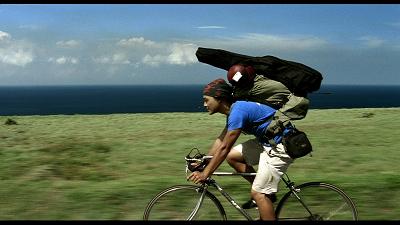
People might remember this movie as the film that replaced Lust, Caution as Taiwan’s representative at the Academy Awards when it was caught in bureaucratic limbo, but it’s one of the best road movies to come out of Asia in the last decade. As a travelogue of Taiwan, Island Etude was far more qualified to represent its home country than the Panasian effort of Lust, Caution (which only qualified for the HK decade film list under the lovehkfilm rules).
23. Departures (2008) - Japan - Directed by Yojiro Takita - LoveHKFilm review.
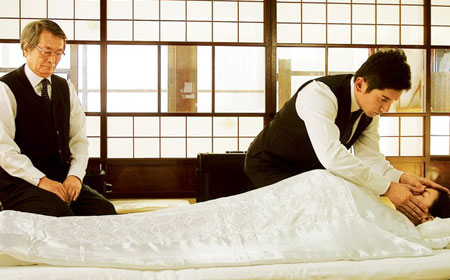
Theoretically, the only Asian film to win Best Picture at the Academy Awards in the last decade ought to be at the top of the list, except…not. Departures is a commercial film calculated to make you cry and laugh at the right times, and when it succeeds the way it does here, it shouldn’t undermine the film. It’s still flawed at points, and it might not have really deserved that Academy Award, but what’s here is commercial Japanese cinema at its best.
22. City of Life and Death (2009) - China - Directed by Lu Chuan - LoveHKFilm review.
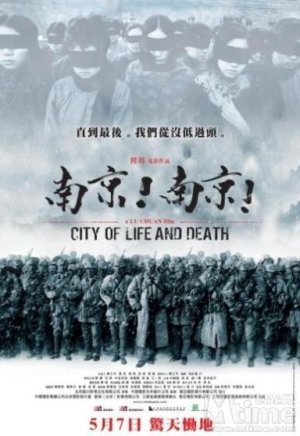
Lu Chuan’s big-budget recreation of the Nanjing Massacre is one of the most controversial Chinese movies of 2009 for its subject matter. In fact, one of my Chinese classmates called it the most sickening film of the year, so that should tell how polarizing the film is even in its own country. Politics and perspectives aside, City of Life and Death is just good filmmaking, with beautiful black-and-white cinematography, striking images, top-notch production values, and finally a take on world war II that doesn’t feel like nationalist propaganda. Not a film I’d visit again soon, but not a film to deny simply based on its subject matter, either.
21. Fish Story (2009) - Japan - Directed by Yoshihiro Nakamura

I can’t possibly think of a better answer to how a punk song from the 1970s save the world from impending disaster than Yoshihiro Nakamura’s Fish Story. Of course, the credit also goes to novelist Kotaro Isaka for the story, which unassumingly sets up seemingly ordinary stories before putting them together in an amazing reveal, but the tour-de-force final minutes where the entire story plays out is pure cinematic genius. And the song is pretty damn good too.
20. The Host (2006) - South Korea - Directed by Bong Joon-Ho - LoveHKFilm review.
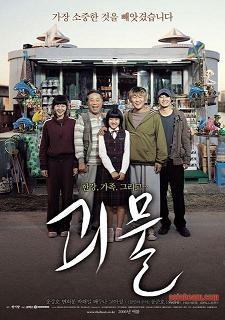
Bong Joon-Ho’s monster flick remains the highest-grossing in Korean history because it knows that unlike movies that bank on nationalist sentiments to support local films, it has to do more than boast special effects. The Host is funny, scary, and even a bit touching, and if you can’t even ask for that in a blockbuster flick - whether it’d be about dragons, robots, or huge tidal waves - then the terrorists would’ve won.
Tomorrow: Numbers 11-19. I miscalculated the separation, and this is what happens.
Posted in feature, review | 1 Comment »
Tuesday, October 13th, 2009
Guess what I’m listening to while I write this entry?
East Screen/West Screen Episode 9
What can I say? I’m narcissistic like that.
On October 8th, 2009, the UA Whompoa cinema closed down for good for the UA cinema chain to make room for their new multiplex in nearby Tsim Sha Tsui.
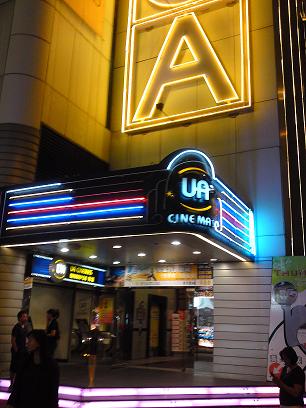
While a theater closing anywhere in Hong Kong is worth lamenting, I have a bit of a connection to this cinema. It provided me with one of my most memorable early cinematic experience.
Once upon a time - more like Christmas time 1992 - the UA Whompoa still had 6 screens: 4 in the main building, and 2 in the big boat across the street. Someone asked me why there’s a boat in the middle of a Hung Hom residential neighborhood. I think it has something to do with its past as a pier.
The family - 4 of us - decided to go to Whompoa that wintery day. Having been built recently at the time, Whompoa was a fairly nice, maybe even fancy, place to live. With several theaters in the area, I still can’t remember why we were there, but I remember that while my brother wanted to watch Gordon Chan’s King of Beggars, starring Stephen Chow, I wanted to watch…..Home Alone 2.
Give me a break, I was 8 years old, damn it.
And so, I became the catalyst for this little family separation. My father and my brother went to King of Beggars, while my mother and I went to Home Alone 2, all the way across the street at the boat. All I remember, aside from the actual movie, was my seat - the left corner, three rows from the screen. Not exactly the best seats, no.
By the next July, I was in America. Don’t remember going back to the UA Whompoa again. Ever. UA Queensway (Now AMC Pacific Place) became the theater of choice for my trips back. I remember seeing Jackie Chan’s Thunderbolt, Kevin Costner’s Waterworld, and even Stephen Chow’s Million Dollar Man at the Queensway, but I don’t remember ever going to the Whompoa since that Home Alone screening. Maybe it was too out of the way, or maybe the movies I saw there sucked more than I care to remember.
And almost 17 years later, the UA Whompoa closed its doors. Before this childhood memory of mine closed for good, I decided to head there to watch one last film, and two of my classmates were game enough to accompany me on this trip down memory lane. Too bad there was nothing memorable playing that I hadn’t seen. So instead, as mentioned in episode 9 of East Screen/West Screen, we watched Jonathan Mostow’s Surrogates.
Perhaps it was due to the fact that it’s the second-to-last night of operation, or the fact that tickets were at a cheap HK$35 a piece (plus a 10% off discount with my credit card), but there was a sizable crowd at the theater. Just past the entrance, there’s a table with all sorts of memorabilia and a spinning wheel. A piece of paper says “One spin for each ticket,” so I approached the employees at the table, hoping for my chance at a piece of usepriceless movie memorabilia.
“So one ticket a spin?” I asked.
“Forget it, this is all we have left. Just take whatever you want!” Said one employee.
The woman hands me a Nim’s Island folder, which I took. I notice a few more things on the table, which the employees seemed more than willing to give to me. On the other end of the table, I see some plastic black things, and the employees passed them along my way.
“They’re card holders,” said the women, “Here, take two!”
So now in my home, I have two things with Evian logos, a Coca Cola refrigerator magnet, a Nim’s Island folder, two Coca-Cola card holders, and perhaps some other thing I can’t recall.
Then I remember I was there for the movie.
So into House B we go. Let’s face it, the Whompoa might’ve been state-of-the-art back then, but it has dated quite quickly since those days. Despite its 500-seat capacity, the screen was relatively small (though it expanded horizontally for widescreen films - a rare sight these days), and the legroom is even smaller. The Whompoa is also one of the few HK theaters that still has DTS for its audio system, and Surrogates packed a mild wallop.
Either way, it was obvious the Whompoa needed a redo years ago.
Walking out of the theater and on the way to the bus stop, the real film buffs have shown up, taking pictures of the UA Whompoa entrance from various angles. We really don’t know what we got ’til it’s gone.
That’s why it’s perhaps not a very good thing that Golden Harvest has decided to take over the Whompoa. They’re giving it a large renovation, and they will reportedly reopen in time for Christmas. Which means maybe I can take my own family there for a Christmas movie there someday. And perhaps we can even decide to watch the same movie.
With the new UA cinema in Tsim Sha Tsui and the impending Golden Harvest Whompoa, there are rumors flying around that Golden Harvest will back out of TST and close their two theaters in the neighborhood - The Golden Gateway (where a major scene of Infernal Affairs was shot) and The Grand Ocean (Probably the only single-screen movie palace left in Hong Kong).
Looks like there’ll be a few more of these entries to do, then.
Posted in feature, Hong Kong | 3 Comments »
Saturday, February 21st, 2009
- Now.com finally updated their Thursday opening day numbers on time for me to make a prediction for this weekend at the Hong Kong box office. As expected, Patrick Kong’s Love Connected led the way, but with only HK$357,000 from 36 screens. That gross is higher than the HK$209,000 opening for Nobody’s Perfect. Either the teens will show up, or it will continue the downward spiral of Patrick Kong. Following close behind is My Bloody Valentine 3D, which managed to make HK$326,000 from 18 screens because of the inflated ticket price. Then again,it may end up winning the weekend exactly because of that.
Clint Eastwood’s Changeling opened on 5 screens with HK$48,000, while Milk also opened on 5 screens, but to just HK$37,000. As the Academy Awards approaches, these films should get a boost over the weekend, at least with per-screen averages.
By the way, Joe Ma and Leefire’s Give Love, which opened on at least 10 screens, didn’t even make it to the top 10, despite the presence of Gigi Leung. More on Monday when the full numbers are out.
- As expected, Departures swept the Japan Academy Prize last night, winning 10 awards, including all the major awards EXCEPT for Best Actress, which went to All Around Us’s Kimura Tae. It’s well-deserved, but I feel a little sorry for Ryoko Hirosue at the same time.
Meanwhile, Ponyo won two awards - Best Animated Film, and Best Music. Paco and the Magical Book won Best Art Direction, and The Dark Knight won Best Foreign Film. The audience awards went to Suspect X for Best Picture and Kenichi Matsuyama for Best Actor.
- Departures is also nominated for Best Foreign Film at the upcoming Academy Awards this weekend. Of course, it’s no surprise that both Japan Times and the Daily Yomiuri have respective features on the film.
The Japan Times piece by Mark Schilling.
The Daily Yomiuri piece by Ikuko Kitagawa.
- In Korea, John Cameron Michell’s sexually explicit film Shortbus will finally be shown in Korea with a restricted rating that will actually allow the film be shown in the country, thanks to a court decision.
- Scud, reportedly the creative driving force behind City Without Baseball, is continuing his obsession with male nudity with the so-called “extreme trilogy”. The first film of that trilogy is Permanant Residence, and here’s the trailer (NSFW for male nudity), with a bad cover of Truly, Madly, Deeply playing in the background. Now we know who was responsible for the bad Cantopop covers in City Without Baseball then.
That’s it for today. More on Sunday to wrap up the weekend.
Posted in awards, United States., feature, animation, blogs, trailers, Hong Kong, Japan, news, South Korea, box office | No Comments »
|
|
|
| |
| |
|
|
|
|
|
|
|
|
|
|
|
|
|
|
|
|
|
|
|
|
|
|
|
|
|
|
|
|
|
|
|
|
|
|
|
|
|
|
|
|
|
|
|
|
|
|
|
|
|
|
|
| LoveHKFilm.com
Copyright © 2002-2025 Ross Chen |
|
|





































